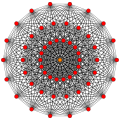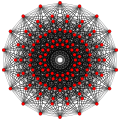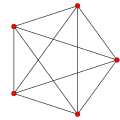Top Qs
Timeline
Chat
Perspective
1 32 polytope
Uniform polytope From Wikipedia, the free encyclopedia
Remove ads
In 7-dimensional geometry, 132 is a uniform polytope, constructed from the E7 group.
Its Coxeter symbol is 132, describing its bifurcating Coxeter-Dynkin diagram, with a single ring on the end of one of the 1-node sequences.
The rectified 132 is constructed by points at the mid-edges of the 132.
These polytopes are part of a family of 127 (27−1) convex uniform polytopes in 7 dimensions, made of uniform polytope facets and vertex figures, defined by all permutations of rings in this Coxeter-Dynkin diagram: ![]()
![]()
![]()
![]()
![]()
![]()
![]()
![]()
![]()
![]()
![]() .
.
Remove ads
132 polytope
Summarize
Perspective
| 132 | |
|---|---|
| Type | Uniform 7-polytope |
| Family | 1k2 polytope |
| Schläfli symbol | {3,33,2} |
| Coxeter symbol | 132 |
| Coxeter diagram | |
| 6-faces | 182: 56 122 126 131 |
| 5-faces | 4284: 756 121 1512 121 2016 {34} |
| 4-faces | 23688: 4032 {33} 7560 111 12096 {33} |
| Cells | 50400: 20160 {32} 30240 {32} |
| Faces | 40320 {3} |
| Edges | 10080 |
| Vertices | 576 |
| Vertex figure | t2{35} |
| Petrie polygon | Octadecagon |
| Coxeter group | E7, [33,2,1], order 2903040 |
| Properties | convex |
This polytope can tessellate 7-dimensional space, with symbol 133, and Coxeter-Dynkin diagram, ![]()
![]()
![]()
![]()
![]()
![]()
![]()
![]()
![]()
![]()
![]()
![]()
![]() . It is the Voronoi cell of the dual E7* lattice.[1]
. It is the Voronoi cell of the dual E7* lattice.[1]
Alternate names
- Emanuel Lodewijk Elte named it V576 (for its 576 vertices) in his 1912 listing of semiregular polytopes.[2]
- Coxeter called it 132 for its bifurcating Coxeter-Dynkin diagram, with a single ring on the end of the 1-node branch.
- Pentacontahexa-hecatonicosihexa-exon (Acronym: lin) - 56-126 facetted polyexon (Jonathan Bowers)[3]
Images
Construction
It is created by a Wythoff construction upon a set of 7 hyperplane mirrors in 7-dimensional space.
The facet information can be extracted from its Coxeter-Dynkin diagram, ![]()
![]()
![]()
![]()
![]()
![]()
![]()
![]()
![]()
![]()
![]()
Removing the node on the end of the 2-length branch leaves the 6-demicube, 131, ![]()
![]()
![]()
![]()
![]()
![]()
![]()
![]()
![]()
Removing the node on the end of the 3-length branch leaves the 122, ![]()
![]()
![]()
![]()
![]()
![]()
![]()
![]()
![]()
The vertex figure is determined by removing the ringed node and ringing the neighboring node. This makes the birectified 6-simplex, 032, ![]()
![]()
![]()
![]()
![]()
![]()
![]()
![]()
![]()
![]()
![]()
Seen in a configuration matrix, the element counts can be derived by mirror removal and ratios of Coxeter group orders.[4]
Related polytopes and honeycombs
The 132 is third in a dimensional series of uniform polytopes and honeycombs, expressed by Coxeter as 13k series. The next figure is the Euclidean honeycomb 133 and the final is a noncompact hyperbolic honeycomb, 134.
Remove ads
Rectified 132 polytope
Summarize
Perspective
The rectified 132 (also called 0321) is a rectification of the 132 polytope, creating new vertices on the center of edge of the 132. Its vertex figure is a duoprism prism, the product of a regular tetrahedra and triangle, doubled into a prism: {3,3}×{3}×{}.
Alternate names
- Rectified pentacontahexa-hecatonicosihexa-exon for rectified 56-126 facetted polyexon (Acronym: lanq) (Jonathan Bowers)[5]
Construction
It is created by a Wythoff construction upon a set of 7 hyperplane mirrors in 7-dimensional space. These mirrors are represented by its Coxeter-Dynkin diagram, ![]()
![]()
![]()
![]()
![]()
![]()
![]()
![]()
![]()
![]()
![]() , and the ring represents the position of the active mirror(s).
, and the ring represents the position of the active mirror(s).
Removing the node on the end of the 3-length branch leaves the rectified 122 polytope, ![]()
![]()
![]()
![]()
![]()
![]()
![]()
![]()
![]()
Removing the node on the end of the 2-length branch leaves the demihexeract, 131, ![]()
![]()
![]()
![]()
![]()
![]()
![]()
![]()
![]()
Removing the node on the end of the 1-length branch leaves the birectified 6-simplex, ![]()
![]()
![]()
![]()
![]()
![]()
![]()
![]()
![]()
![]()
![]()
The vertex figure is determined by removing the ringed node and ringing the neighboring node. This makes the tetrahedron-triangle duoprism prism, {3,3}×{3}×{}, ![]()
![]()
![]()
![]()
![]()
![]()
![]()
![]()
![]()
![]()
![]()
Seen in a configuration matrix, the element counts can be derived by mirror removal and ratios of Coxeter group orders.[4]
Images
Remove ads
See also
Notes
References
Wikiwand - on
Seamless Wikipedia browsing. On steroids.
Remove ads

















 ,
,  ...
...

 ...
...











